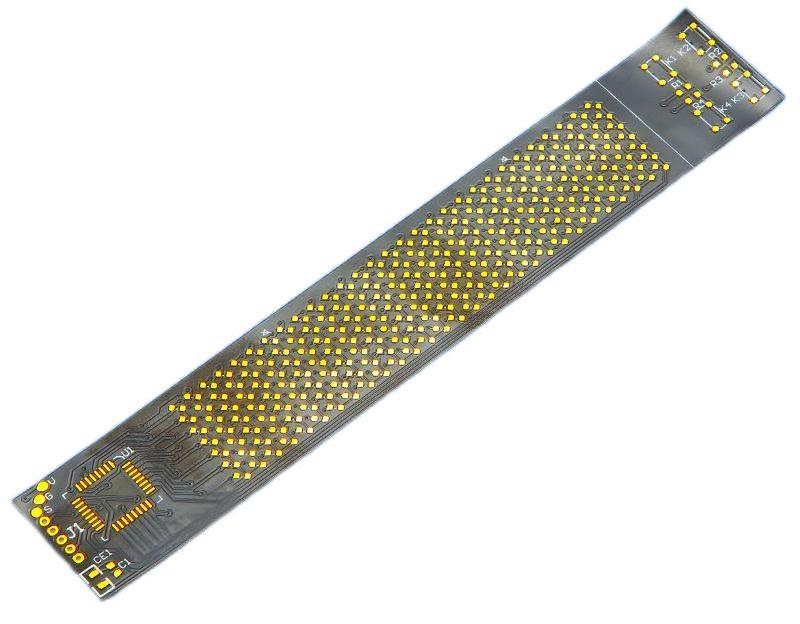Search
LED FPC Roll-to-Roll Manufacturing: Key Challenges & Solutions
- Mar 13,2025
-
Share
By Shenzhen Huaruixin Electronics Co., Ltd. – Leading Innovator in Flexible Circuit Solutions
As a trusted provider of high-precision FPC, PCB, and rigid-flex printed boards, Shenzhen Huaruixin Electronics specializes in delivering cutting-edge solutions for advanced LED applications. Below, we delve into the technical nuances of LED FPC roll-to-roll manufacturing, offering professional insights into design challenges, process optimization, and troubleshooting strategies.

I. Key Design Challenges
1. Material Selection
Substrate: Choose polyimide (PI) for high-temperature resistance (up to 250°C) and dimensional stability. For cost-sensitive applications, polyester (PET) provides a viable alternative but with reduced thermal endurance.
LED Components: Select chips with matched coefficient of thermal expansion (CTE) to prevent thermo-mechanical stress. High-brightness SMD LEDs (e.g., 0603, 0402) are ideal for compact designs.
Conductive Layers: 1/3 oz or 1/2 oz electrolytic copper foil ensures low resistivity (<1.7 μΩ·cm) and EMI shielding capabilities.
Coverlay: Opt for UV-stabilized polyimide or silicone-based materials to minimize optical degradation.
Huaruixin Insight: We leverage laser-cut PI coverlays with ±10 μm precision for conformal protection of LED arrays.
2. Thermal Management
Copper Planes: Implement thermal vias (0.3–0.5 mm diameter) and heat spreaders to dissipate heat from LED junctions.
Simulation: Use ANSYS Icepak to model thermal gradients and validate junction-to-ambient thermal resistance (RthJA < 20°C/W).
3. Mechanical Robustness
Bend Radius: Design for a minimum bend radius of 5–10× substrate thickness (e.g., 0.125 mm PI requires ≥0.625 mm radius).
Stiffeners: Apply FR4 or PI stiffeners (0.1–0.3 mm thick) at FPC-to-connector interfaces to enhance peel strength (>1.5 N/mm).
II. Roll-to-Roll Process Optimization
1. Process Parameter Control
Process | Critical Parameters | Target Range |
Tension Control | Magnetic powder brake | 5–15 N (±0.5 N stability) |
Exposure | UV energy density | 800–1200 mJ/cm² (365 nm wavelength) |
Electroless Nickel Immersion Gold (ENIG) | Nickel thickness | 5–8 μm, gold thickness 0.05–0.15 μm |
Reflow Soldering | Peak temperature | 245–255°C (SnAgCu alloy) |
Huaruixin Advantage: Our servo-driven tension system maintains ±0.3 N stability, ensuring consistent linewidths (<±15 μm deviation).
III. Common Defects & Remedial Actions
1. Cold Joints
Symptom: LED detachment or high contact resistance (>50 mΩ).
Root Cause: Insufficient wetting due to low reflow temperature or oxidized pads.
Solution:
Optimize reflow profile: Preheat (150–180°C for 60–90s) → Reflow (245–255°C for 10–15s).
Implement ENIG surface finish for superior solderability.
2. Line Misregistration
Symptom: Trace offset >50 μm.
Root Cause: Registration errors in LDI exposure or etch bias miscalibration.
Solution:
Use laser direct imaging (LDI) with ±10 μm accuracy.
Apply dynamic etch factor compensation (EFC) for precise feature definition.
3. Substrate Wrinkling
Symptom: Visible folds or creases in the FPC.
Root Cause: Uneven tension distribution or improper roller alignment.
Solution:
Install ultrasonic tension sensors for real-time monitoring.
Calibrate rollers to <0.05 mm parallelism.
4. Optical Degradation
Symptom: Yellowing of coverlay after UV exposure.
Root Cause: Organic material degradation.
Solution:
Upgrade to silicone-based encapsulants with UV stabilizers.
Implement inert nitrogen reflow (<50 ppm O₂) to reduce oxidation.
Huaruixin Innovation: Our AI-powered AOI system achieves 99.8% defect detection accuracy, flagging micro-cracks and solder bridging in real time.
IV. Quality Assurance & Compliance
Reliability Testing:
Thermal cycling (-40°C to 125°C, 1,000 cycles).
Humidity bias testing (85°C/85% RH, 1,000 hours).
Certifications: Compliant with IPC-6013 Class III and RoHS 2.0 standards.
Engage with Huaruixin Electronics
For over a decade, we have pioneered advancements in flexible circuit technology, empowering industries from automotive lighting to wearable devices. Whether you need customized thermal management solutions or high-volume roll-to-roll production, our engineering team is ready to collaborate.
Connect with us:sales@hrxfpc.com | Website
#FPCManufacturing #LEDTechnology #FlexibleCircuits #AdvancedPackaging
Disclaimer: Technical specifications are subject to change. Contact us for detailed product documentation.
This blog is proudly produced by Shenzhen Huaruixin Electronics Co., Ltd. – Where Engineering Excellence Meets Industrial Innovation.

Let’s talk! We’ll provide the perfect solution for you!
-
 Huaruixin Electronics mainly produces printed circuit boards as the core business, to provide customers with one-stop solutions for FPC/PCB production, components sourcing and Assembly.
Huaruixin Electronics mainly produces printed circuit boards as the core business, to provide customers with one-stop solutions for FPC/PCB production, components sourcing and Assembly. - WHAT WE DO — PCB Design Solutions — Flex PCB Production — Components Sourcing — FPC&PCB Assembly
- PRODUCTS — Single Sided Flexible Circuits — Double Sided Flexible Circuits — Multilayer Flexible Cirucits — Rigid-Flex Circuits — FPC Assembly — PCB Assembly
- CAPABILITY — FPC Capability — Rigid-Flex Capability — PCB Capability — Assembly Capability
- Copyright © 2024 Shenzhen Huaruixin Electronics Co., Ltd. All Rights Reserved.
- Design By BONTOP


